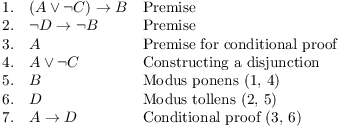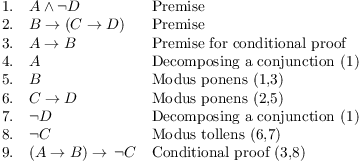A conditional proof is a proof of an "if-then" (conditional) statement.
Since any proof makes some assumptions, you might say that every proof is a conditional proof. But there are different kinds of assumptions you might make. Consider the following conditional statements:
"If ![]() , then
, then ![]() ."
."
"If ![]() and
and ![]() , then
, then ![]() ."
."
There's an obvious sense in which the "if" part of the second statement has more content that the "if" part of the first statement. In the first statement, the "if" part doesn't give you much to go on. In the second statement, you would suspect that the number 3 is somehow related to the "then" part.
In this section, I'll look at proofs of conditional statements where the "if" part carries that kind of significant information.
Example. Prove that if ![]() and
and ![]() , then
, then ![]() .
.
To prove the statement, you assume that ![]() . Now
. Now
![]()
Likewise,
![]()
If I add ![]() and
and ![]() , I get
, I get ![]() . I compare this inequality to the target
inequality, and I see that I'm missing a "2" on the left
and a "1" on the right. Well,
. I compare this inequality to the target
inequality, and I see that I'm missing a "2" on the left
and a "1" on the right. Well, ![]() , so adding this inequality to
, so adding this inequality to ![]() , I obtain
, I obtain
![]()
Notice the conditional nature of the conclusion. It's
certainly not true that ![]() for any
real number x. (For example, it's false if
for any
real number x. (For example, it's false if ![]() .) The conclusion is true if the assumption
.) The conclusion is true if the assumption
![]() is true.
is true.![]()
The last example shows how you write a conditional proof. In this
situation, you're trying to prove a statement of the form ![]() , where P is the set of assumptions --- it may be one
statement, or several statements --- and Q is the conclusion. You
assume P and try to derive Q. If you succeed, then
, where P is the set of assumptions --- it may be one
statement, or several statements --- and Q is the conclusion. You
assume P and try to derive Q. If you succeed, then ![]() is true.
is true.
Example. (a) Prove that if x is a real number
and ![]() , then
, then ![]() .
.
(b) Give a specific example to show that the converse is false.
(a) Suppose ![]() . Then
. Then
![]()
Thus, ![]() ,
, ![]() , and x are all
positive. The product of positive numbers is positive, so
, and x are all
positive. The product of positive numbers is positive, so
![]()
(b) Take ![]() . Then
. Then
![]()
However, ![]() .
.![]()
For the next few examples, recall that an integer n is even if it can be written as ![]() for some integer m.
for some integer m.
An integer n is odd if it can be written as
![]() for some integer m.
for some integer m.
Example. ( Proving the
contrapositive) Let n be an integer. Prove that if ![]() is not even, then n is not even.
is not even, then n is not even.
Recall that the conditional ![]() is logically
equivalent to its contrapositive
is logically
equivalent to its contrapositive ![]() .
In some cases, you use this to prove a conditional statement by
replacing it with its contrapositive.
.
In some cases, you use this to prove a conditional statement by
replacing it with its contrapositive.
In this example, the given conditional statement is kind of awkward:
Both the "if" and "then" parts are negative
statements. And if I try to prove this conditional statement by
assuming the "if" part --- that is, assuming that ![]() is not even --- it isn't obvious how to
proceed.
is not even --- it isn't obvious how to
proceed.
Instead, I replace the statement with its contrapositive: "If n
is even, then ![]() is even."
is even."
Begin by assuming the "if" part: Suppose n is even. By
definition, this means that ![]() , where m is an
integer. Then
, where m is an
integer. Then

Now ![]() is an integer, so
is an integer, so ![]() is even (by definition of
"even"). Hence,
is even (by definition of
"even"). Hence, ![]() is even.
is even.
Since I've proved the contrapositive, this proves the original
statement.![]()
If a and b are integers, a divides b means
that there is an integer c such that ![]() . a divides b is written
. a divides b is written ![]() for short.
for short.
For example, ![]() because
because ![]() ,
, ![]() because
because ![]() , and
, and ![]() since
since ![]() .
.
On the other hand, 3 does not divide 5, since there is no integer c
such that ![]() . "3 does not divide 5"
is written
. "3 does not divide 5"
is written ![]() .
.
Note that an integer n is even if and only if ![]() .
.
Example. Prove that if n is an integer and n
is divisible by 3, then ![]() is divisible by
3.
is divisible by
3.
Note that you have to prove this directly from the definition and rules of algebra; you can't assume "obvious" things like "the sum of numbers divisible by 3 is divisible by 3" (unless you prove these "obvious" things first!).
Suppose n is divisible by 3. Then ![]() for some integer
m. So
for some integer
m. So
![]()
The last expression is 3 times an integer. Hence, ![]() is divisible by 3.
is divisible by 3.![]()
Note that I didn't stop with "![]() "
and say "the sum of integers divisible by 3 must be divisible by
3". That's true, but I haven't proved it. Can you do it?
"
and say "the sum of integers divisible by 3 must be divisible by
3". That's true, but I haven't proved it. Can you do it?
Example. Prove that if n is odd, then ![]() leaves a remainder of 1 when it is divided by 4.
leaves a remainder of 1 when it is divided by 4.
I assume that n is an odd number. I want to prove that ![]() leaves a remainder of 1 when it is divided by 4.
leaves a remainder of 1 when it is divided by 4.
An odd number is an integer which can be written in the form
![]() for some integer m. Since n is odd,
for some integer m. Since n is odd, ![]() for some m.
for some m.
Squaring n, I get
![]()
Since ![]() is divisible by 4,
is divisible by 4, ![]() leaves a remainder of 1 when it is divided by 4.
leaves a remainder of 1 when it is divided by 4.
This proves the conditional statement that if n is odd, then ![]() leaves a remainder of 1 when it is divided by 4.
leaves a remainder of 1 when it is divided by 4.![]()
A conditional proof in logic will be a proof of a statement of the
form "![]() ". To do this:
". To do this:
(a) State the premises.
(b) Introduce P as a new premise. Label it "Premise for conditional proof".
(c) Prove Q from P and the given premises using rules of inference as usual.
(d) Conclude "![]() ". Label it
"Conditional proof", and include the numbers of the
statements for P and for Q.
". Label it
"Conditional proof", and include the numbers of the
statements for P and for Q.
Example. Premises: ![]()
Prove: ![]() .
.
To prove the conditional statement ![]() , I
assume the "if" part A and try to prove the
"then" part D.
, I
assume the "if" part A and try to prove the
"then" part D.

The then-part D was proved in line 6. Together with the if-part A in
line 3, this proves the conditional ![]() .
.![]()
Example. Premises: ![]()
Prove: ![]() .
.
To prove the conditional statement ![]() , I assume the "if" part
, I assume the "if" part ![]() and try to prove the "then" part
and try to prove the "then" part ![]() .
.

The then-part ![]() was deduced on line 8. Together
with the if-part
was deduced on line 8. Together
with the if-part ![]() in line 3, this proves the
conditional
in line 3, this proves the
conditional ![]() .
.![]()
Copyright 2019 by Bruce Ikenaga